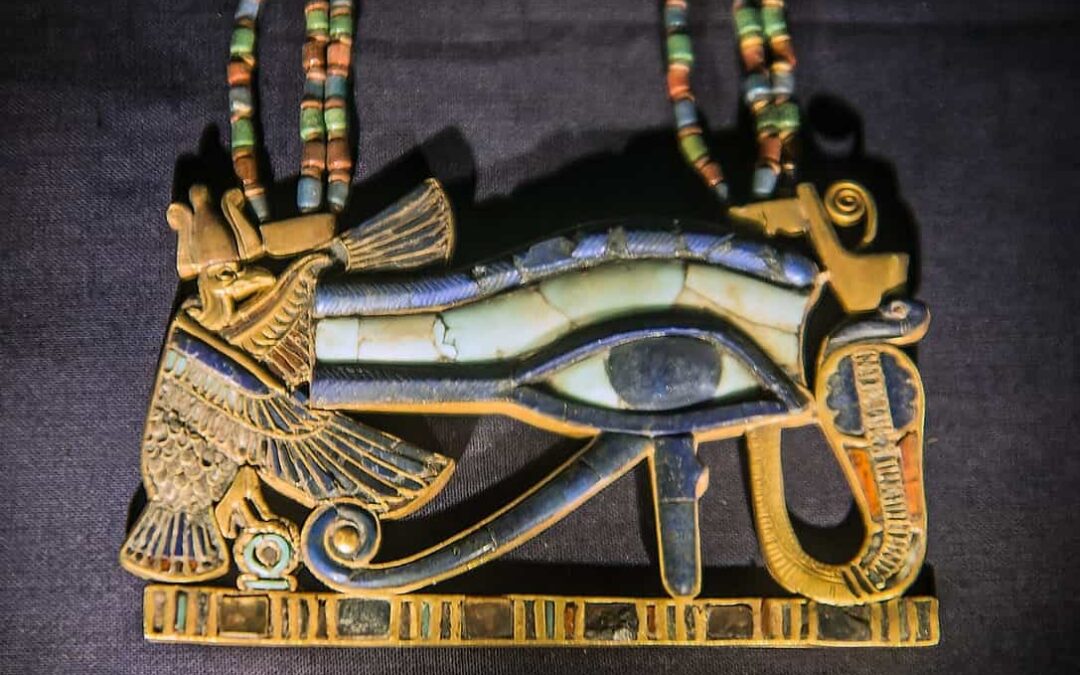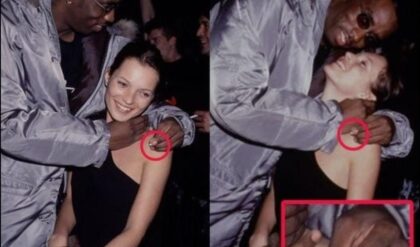
The Eye of Horus stands as one of the oldest known amulets, with documented testimonies dating back to the Old Kingdom. Among its well-known meanings are health, royalty, and rebirth.
Generally, amulets served as magical objects commonly included in the ancient Egyptians’ funerary trousseau. However, they also held daily-life significance as apotropaic elements, imbuing the wearer with supernatural or protective powers.
In funerary contexts, these amulets were typically placed on the mummy, sewn into the bandages, or inserted between the various layers of linen wrapping the mummified body. Some were also fashioned into necklaces. These protective talismans were believed to aid the deceased in their journey to the afterlife.The protective attributes of the Eye of Horus were linked to both the material and color of the eye, alongside the rituals and spells associated with it.
Several incantations prescribing the type of material, shape, and color for these amulets are found in the “Book of Coming Forth Into Day” (or “Book of the Dead”). These incantations even specify the precise positioning of these amulets on the deceased’s body.
For instance, in chapter 140 of the Book of the Dead, there’s a reference to the sun as the eye, with the incantation specifying, “Said over an eye of pure lazuli or mak stone adorned with gold; an offering is made before him of all good and sacred things.”
Another mention is made of an eye made of jasper, “which a man shall put on any of his members that he chooses.” Chapter 167 also refers to an eye of Horus, or wedjat, brought by Djehuty, i.e., the god Thoth.
The materials utilized in crafting these amulets varied widely: obsidian, lapis lazuli, faience, jasper, and even copper or wood. The choice of material, and consequently the resulting color, carried precise meanings that contributed to enhancing their protective properties.
The Powerful Amulet of the Eye of Horus
In our context, the Eye of Horus as an amulet symbolizes the eye that Horus lost during the battle with Seth, his brother or uncle, depending on the version of the narrative consulted.
The significance of this body part transformed it into a protective amulet. According to legend, when the eye was restored to Horus, he utilized it to resurrect his slain father, the god Osiris, reassembling all the parts of his shattered body.
This event’s significance lies in the concept of restored unity. In remembrance of this event, a wedjat eye was frequently placed over the evisceration wound on the mummy, symbolically reuniting the body much like Osiris’. This amulet held such power that it could replace the actual food offerings typically presented in the daily rituals for the deceased.
The depiction of the Eye of Horus combines a human eye and an eyebrow. Additionally, below the eye, there is a teardrop and a loop, distinctive marks representing the female or male wool falcon, a characteristic bird of Africa.
Beyond being a physical amulet, the Eye of Horus, or a pair of eyes, was a part of the decorative motifs found on the coffins from the Old Kingdom and the Middle Kingdom predominantly. Positioned on the left side of the coffin, this protective symbol granted the deceased the ability to observe the external world through them. Thus, by aligning with Horus, the deceased was believed to perceive through the eyes of the god.

The Mysterious Aspects of Divine Order in Egyptian Mythology
Within ancient Egyptian mythology, the eye of Horus or the wedjat eyes, given their dual nature as a pair, symbolize the two eyes of the god Horus and draw comparisons to the sun and the moon. When envisioning Horus as a celestial falcon, his right eye was associated with the sun, while his left eye represented the moon.
The moon’s association stemmed from the waxing and waning lunar cycles. Its decrease paralleled the injury to the eye, and its restoration corresponded to its increase.
In ancient Egypt, the term for “eye” was a feminine noun, allowing for the personification of the eyes of male deities as goddesses. The temporary loss or mutilation of one or both of Horus’s eyes was a recurring motif in mythology.
Seth was the aggressor responsible for the assault on Horus, endangering the entire cosmos. The stability of the cosmic order hung in the balance, requiring restoration. While some accounts suggest Horus retrieved his own eye, the prevailing belief attributes his restoration to Thoth.
The wedjat eye possessed the capacity to symbolize various aspects of the divine order, encompassing kingship and offerings presented to both gods and the deceased.
In ancient Egyptian mythology, Horus had multifaceted manifestations. As Horus the Elder, he was described as having one green eye and one white or “lesser” eye.
The color green, at times, held equivalence to red in Egyptian symbolism, thus representing the sun eye. The white (or silver) eye symbolized the moon. Consequently, the red and white crowns worn by Egyptian kings were associated with the solar and lunar eyes.
News
Unveiling the Ingenious Engineering of the Inca Civilization: The Mystery of the Drill Holes at the Door of the Moon Temple in Qorikancha – How Were They Made? What Tools Were Used? What Secrets Do They Hold About Inca Technology? And What Does Their Discovery Mean for Our Understanding of Ancient Construction Methods?
In the heart of Cusco, Peru, nestled within the ancient Qorikancha complex, lies a fascinating testament to the advanced engineering prowess of the Inca civilization. Here, archaeologists have uncovered meticulously angled drill holes adorning the stone walls of the Door…
Unveiling the Sun Stone: Aztec Relic from the Reign of Moctezuma II (1502-1520) – What Secrets Does It Hold? How Was It Used? What Symbolism Does It Carry? And What Does Its Discovery Reveal About Aztec Culture?
In the heart of Mexico City, amidst the bustling Plaza Mayor, lies a silent sentinel of ancient wisdom and artistry – the Sun Stone. This awe-inspiring artifact, dating back to the reign of Moctezuma II in the early 16th century,…
Uncovering the Past: Rare 1,000-Year-Old Copper Arrowhead Found – Who Crafted It? What Was Its Purpose? How Did It End Up Preserved for So Long? And What Insights Does It Offer into Ancient Societies?
In the realm of archaeology, every discovery has the potential to shed light on our shared human history. Recently, a remarkable find has captured the attention of researchers and enthusiasts alike – a rare, 1,000-year-old copper arrowhead. This ancient artifact…
Unveiling History: The Discovery of an Old Sword in Wisła, Poland – What Secrets Does It Hold? Who Owned It? How Did It End Up There? And What Does Its Discovery Mean for Our Understanding of the Past?
In a remarkable archaeological find that has captured the imagination of historians and enthusiasts alike, an old sword dating back to the 9th-10th century AD has been unearthed in Wisła (Vistula River) near Włocławek, Poland. This discovery sheds light on the rich…
Unveiling the Hidden Riches: Discovering the Treasure Trove of a Notorious Pirate – Who Was the Pirate? Where Was the Treasure Found? What Historical Insights Does It Reveal? And What Challenges Await Those Who Seek to Uncover Its Secrets?
A group of divers said on May 7 that they had found the treasure of the infamous Scottish pirate William Kidd off the coast of Madagascar. Diver Barry Clifford and his team from Massachusetts – USA went to Madagascar and…
Excavation Update: Archaeologists Unearth Massive Cache of Unopened Sarcophagi Dating Back 2,500 Years at Saqqara – What Secrets Do These Ancient Tombs Hold? How Will They Shed Light on Ancient Egyptian Burial Practices? What Mysteries Await Inside? And Why Were They Buried Untouched for Millennia?
Egypt has unearthed another trove of ancient coffins in the vast Saqqara necropolis south of Cairo, announcing the discovery of more than 80 sarcophagi. The Tourism and Antiquities Ministry said in a statement that archaeologists had found the collection of colourful, sealed caskets which were…
End of content
No more pages to load











